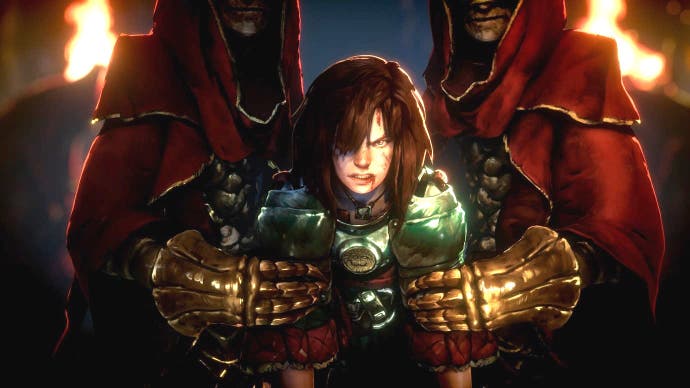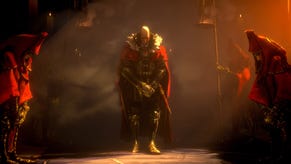No Rest For the Wicked early access review - a shaky start, but there's potential
I-soul-metric.
No Rest for the Wicked feels like a bit of a missing link. In the same way that Salt and Sanctuary bridged a gap between Metroidvanias and the Souls series, No Rest exists as a stop on an imaginary evolutionary journey from Diablo-style action RPGs and the aforementioned Souls both Demonic and Dark. Taking the isometric view and randomised loot from the former, and the exploration and more measured approach to combat from the latter, No Rest attempts to craft something new from familiar ingredients.
At first, I thought it was a horrible mistake. After a brief tutorial, you're shipwrecked on the island of Sacra and left to find your way to the nearest settlement. Almost immediately, the clash between the two disparate game styles becomes apparent, and the focal point of this dissonance is loot.
Dark Souls and Diablo have two completely opposing philosophies when it comes to loot. In the Souls games, almost every piece of gear is deliberately placed, and even randomly dropped loot comes from specific enemies. Your pool of healing items is small, but it refreshes on every death and checkpoint. There's little guidance for building your character, but you can pick a starting loadout that is geared towards your preferred playstyle. You'll probably be able to complete the game with that starting gear too, since it upgrades, and the combat is designed more around preference than any given sword being obviously better than another.
Diablo is the exact opposite. It throws heaps of randomised loot at you with loads of stat bonuses and, until the endgame, it's all pretty disposable as there's always something better around the next corner, hiding in the next chest. Potions are finite, but you can have dozens of them and chain-chug them while cleaving your way through hordes of enemies. You'll probably start off with next to no gear, but there will be skill trees to progress through that give you at least a vague idea of what you're doing.
No Rest's opening few hours offers the worst of both worlds. You start as a completely blank slate, as if you'd picked the obligatory Soulslike class that sees you in your underwear carrying a slightly damp stick. Staggering around the beach you wake up on, using whatever gear you stumble across, you have no real idea of what kind of build you might want to have, or what the options really are. Around this time, I spent some points to increase my strength and equip load, with an eye to going for some kind of tank or two-hander build, and managed to get all the up to the first boss before I even found a strength-scaling weapon.
.jpg?width=690&quality=75&format=jpg&auto=webp)
.jpg?width=690&quality=75&format=jpg&auto=webp)
Dying in No Rest is a bit odd. You don't lose any experience, but your equipment takes a durability hit. Initially this was incredibly punishing, but Moon Studios reduced both the amount of damage and the repair costs in the first patch. In a big break from the Soulslike norm, enemies don't respawn when you die and, crucially, neither do resource gathering points. Yes, the game has a huge gathering and crafting component. It's all familiar stuff, mining ore, picking herbs, that kind of thing. The biggest impact, at least initially, is on healing. In No Rest, you heal by eating meals, which you have to cook from at least two ingredients, including some kind of food and a special healing herb. Meals have to be prepared at fire pits, which aren't necessarily nearby respawn points, and your supply is, at least initially, extremely limited.
As a result, your first couple of hours in No Rest will be spent in a battle of attrition against the enemies in your path, with you repeatedly flinging yourself against them and hoping that you can take one down before you die. Eventually you'll make some progress, find some more ingredients, cook a few meals and proceed in a more dignified fashion, at least until you run out again. Resources do eventually respawn, thankfully. No Rest utilises a fog of war mechanic, with the map slowly being revealed as you explore, but then slowly greying out as you spend time outside of a given area. Return to one of these greyed-out sections, and you'll find resources have respawned along with - given enough time - any enemies. In practice, this means that you're doing supply runs just to get basic healing items, which may then be consumed in the process of gathering them.
.jpg?width=690&quality=75&format=jpg&auto=webp)
.jpg?width=690&quality=75&format=jpg&auto=webp)
.jpg?width=690&quality=75&format=jpg&auto=webp)
It doesn't help that the combat itself takes some getting used to. While the Soulslike influence is clear, there's more than a dash of isometric action games like Hades, especially once you have a few levels under your belt and some better gear. In a way, that's the elephant in the room here. Yes, deliberately blending Diablo and Dark Souls is a new idea, but with Hades being one of the biggest successes of recent years, I don't think anyone is going to be convinced that dodging around fighting enemies while managing limited resources from an isometric perspective is particularly innovative.
No Rest doesn't make a good first impression, then. Yes, it looks gorgeous, but the first couple of hours or so are definitely showing the game at its worst. The widely-reported performance issues are a big problem, with severe framerate dips and stuttering being apparent on my 3070Ti-based desktop. Combat is initially pretty rough, with both your health and stamina pools being limited, while your foes seem better equipped, tougher and faster than you.
.jpg?width=690&quality=75&format=jpg&auto=webp)
.jpg?width=690&quality=75&format=jpg&auto=webp)
The story being presented doesn't give you much reason to persevere either. You're some kind of special warrior called a Cerim, though no-one can be bothered to explain why you're special, or why everyone seems to react to you with awe or disdain. There's a terrible plague, which will come as a shock to precisely nobody. Would you be surprised to learn that the old king has died? Or that his son has thrown his support behind an especially overzealous and murdery religious order? Didn't think so.
Thankfully, it gets better. A lot better. Once you arrive in the hub city and pick up a few quests, No Rest starts to take shape. There are numerous vendors and a guard captain who hands out daily and weekly bounty quests. Fast travel is unlocked, but only between the city and the last checkpoint you visited. I soon found myself engrossed in the rather compelling gameplay loop, travelling out to an area, exploring it thoroughly, completing quests and gathering materials, before fast travelling back once my pockets got full. Neither the overworld areas nor any of the dungeons I encountered were especially large, but they are all incredibly dense, packed with shortcuts and hidden nooks and crannies, and they're arranged with impressive verticality. Navigation does take some getting used to, as you have no control over the camera (I was constantly flicking the the right thumbstick at first, trying to exert some control) and No Rest is a lot more permissive than you might expect when it comes to clambering over rocks and fallen masonry. A lot of obstacles that I thought were impassable just took a bit of thought and some careful jumps.
.jpg?width=690&quality=75&format=jpg&auto=webp)
There's also plenty to do in the city itself. It's in a bit of a sorry state when you arrive, but contributing raw materials to the local builder allows you to upgrade various shops, services and structures, giving you better access to gear and quicker navigation through the streets. After completing a particular quest, you're given permission to buy a house of your own, which you can decorate with furniture that you craft or buy. Yep, someone slipped a little Animal Crossing into your dark fantasy ARPG.
After playing No Rest for the Wicked for a few days, I'm cautiously optimistic. The big problems with the game are all eminently fixable, whether it's the performance issues or the rough early game. As Moon Studios has been quick to respond to feedback, I'm sure things will be sorted sooner, rather than later. At the same time, I'm worried that the two competing loot philosophies will never quite mesh, as no-one wants to put resources into upgrading a weapon when an even better one could appear any moment, - even the same one, but with better base stats. I also realised that, other than the aesthetic, which I adore, nothing about the game blew me away. I didn't have any wow moments, I didn't see anything that was either new or done better than I'd seen elsewhere. While I did eventually start enjoying myself and I will be continuing to keep an eye on No Rest as it develops, it's going to need to be much greater than the sum of its parts to make any real impact.
Review code for No Rest for the Wicked was provided by Private Division.



.jpg?width=291&height=164&fit=crop&quality=80&format=jpg&auto=webp)


.jpg?width=291&height=164&fit=crop&quality=80&format=jpg&auto=webp)
